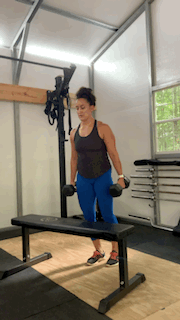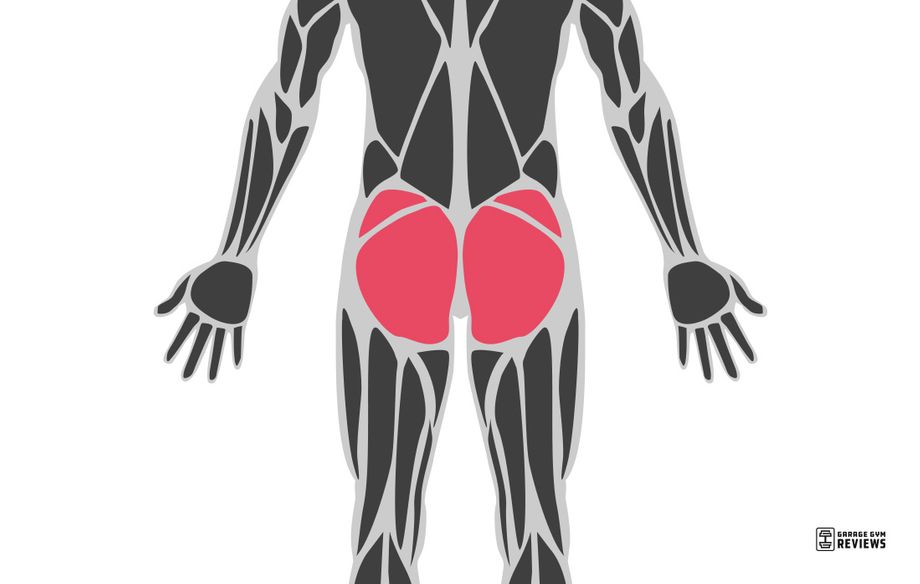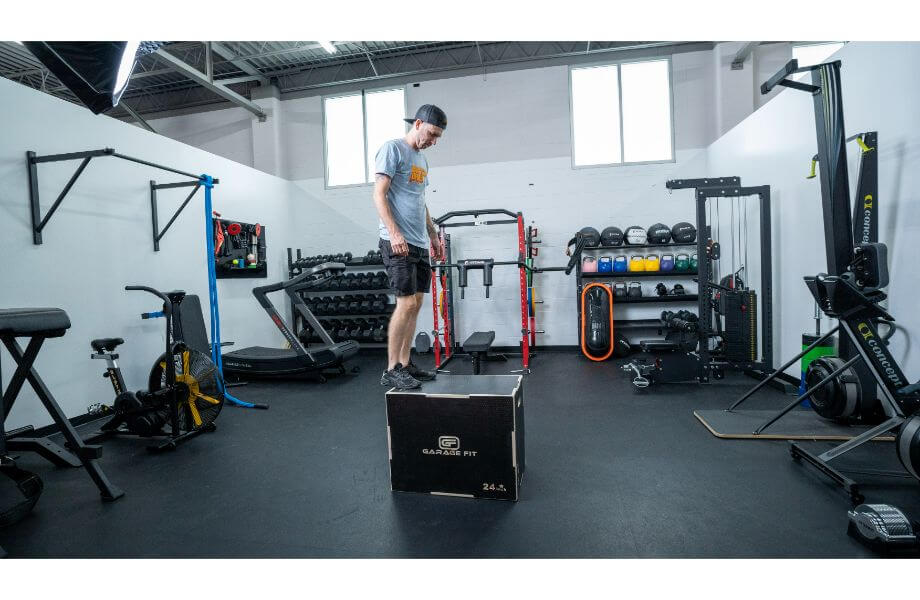We test and review fitness products based on an independent, multi-point methodology. If you use our links to purchase something, we may earn a commission. Read our disclosures.
There are many excellent single-leg exercises, like lunges, to build and strengthen your legs and butt. Single-leg or unilateral leg exercises improve your static and dynamic balance and strengthen imbalances between sides for better muscle development. The problem is that most experienced exercisers know this and avoid them anyway.
The most avoided of them all, besides the Bulgarian split squat, is the innocuous step-up exercise. It seems simple and non-technical because all you do is put your foot on a weight bench and step up so your feet are together. But it is more complicated than it looks, and there is more than meets the eye with this exercise.
Here, we’ll dive into everything step-up so you will avoid this exercise no more!
How To Do a Bodyweight Step-Up
- To start the step-up, put your left foot on a weight bench so your left knee is at a 90-degree angle.
- Lift your right foot off the ground and transfer your weight to your left foot as you activate your glutes and leg muscles to step up onto the bench.
- Once your left leg is locked out, place your right foot down on the bench so your feet are together. You can also drive your right leg into a high knee first to increase the intensity.
- Step slowly back down to the starting position and reset and repeat, either stepping with the same leg for all reps before switching or alternating sides.

4 Benefits of Step-Up Exercises
Step-ups can make you look foolish quickly, so there must be benefits to performing this exercise, right? Yes—and here are four awesome benefits of the step-up exercise.
It’s Not Technical and Is Easily Progressed
All you need for step-ups is a weight bench or box and the desire to challenge yourself, making it an excellent exercise for beginners and advanced lifters. The step-up is not a technical exercise like barbell deadlifts and requires minimal instruction, and is progressed by increasing the height of the box or performing weighted step-ups like the barbell step-up.
Better Single-Leg Balance
Performing step-ups regularly in your workout will improve your balance because you’re going through a large range of motion as you step up and down on one leg. Plus, you will focus more because you don’t want to lose balance and embarrass yourself.
Improved Muscle Development of the Glutes and Quads
Performing single-leg exercises like step-ups strengthens imbalances between sides, leading to better and more even muscle development in the quads and glutes.
Easier on the Lower Back
Step-ups, like a lot of unilateral movements, the spine has a less compressive load, which means less stress, so your spine is under less pressure. And because step-ups are unilateral, you don’t need as much load to get a training effect.
What Muscles Do Step-Ups Work?
The step-up primarily works the lower body and core with little involvement from the upper body, except when you use dumbbells, kettlebells, or barbells. Here are the primary muscles strengthened by the step-up.
RELATED: Best Olympic Barbell
Quadriceps: All four quad muscles on the front of your thigh work together to extend the knee as you’re stepping up.
Glutes: The glutes have two functions during the step-up. One is a hip extender because the hip starts in flexion, and two is a hip stabilizer to keep you balanced.

Hip Adductors: Gives your knees stability to avoid collapsing inward.
Hamstrings: Assists the glutes with hip extension during the concentric contraction, and the hamstring’s eccentric strength helps your lower down without crashing your foot to the ground.
Calves: The anterior and posterior calf muscles work hard to keep you balanced on one leg.
Certified Personal Trainer Tips for Form
Step-ups are simple, but there are a few things to pay attention to in order to get the most out of this fantastic exercise and ensure proper form.
Choosing the Step-Up Height
A general rule on step-up height is that your knee forms a 90-degree angle when your foot is elevated. Reducing your step-up height is a good idea if you’re a beginner or if you have knee pain.
Torso Positioning
First, you disadvantage your anterior and posterior core if your torso leans too far forward, particularly if you’re stepping up too high, which will stress your lower back and not your quads and glutes. Sticking to a ROM you can control and that doesn’t cause potential issues is better.
Use the Front Foot
The point of this exercise is for the front leg to do the work to add juice to your quads and glutes. Ensure your push through your front foot and use the back leg as support. But there can be a tendency to push off the back leg, especially when you get tired. Doing so makes it easier, and you will lose muscle-building tension on the lead leg.
Lower with Control
Step-ups are a demanding exercise, and when you get tired at the end of your repetition range, you tend to drop the back foot and neglect to control the eccentric contraction. Not only is this not great for your joints, but you’ll lose muscle-building tension.
Step-Up Variations
When you have mastered the regular step-up, take these three variations out for s spin to keep progressing with your glute and quad gains.
Lateral Step Up
The lateral step-up has you stepping onto the box laterally, not up and down. Stepping up laterally trains all three glute muscles (gluteus maximus, medius, and mini) and is a progression from the standard step-up because it requires more balance and coordination.
Sprinter Step Up
This step-up variation is more explosive on the concentric part, and you’ll use arm and knee drive to step up. It almost mimics the action of a sprinter, hence the name. The sprinter step creates hip separation (extending one hip while flexing the opposite hip), which is needed for many lower body exercises and other athletic movements.
Crossover Step-Up
With the lead leg off center and across your body, you add rotation to the mix with the crossover step-up. This challenges your balance and core strength, adding internal and external rotation of the hips for better muscle development.
RELATED: Best Core Exercises Equipment
Useful Step-Up Equipment
Access to a plyometric box or a weight bench is necessary for this exercise. Load is optional, but if you want to progress the step-up, dumbbells and kettlebells are great tools to use.
RELATED: The Best Kettlebells
FAQs: Step-Up Exercise
What are step-up exercises good for?
Step-ups are not a one-rep max type of exercise, but rather an exercise you perform to improve your balance, reduce your strength imbalances between legs, and improve the muscle development of your quads and glutes.
Is step up better than squats?
Squats are full-body bilateral exercises where you will use more load to add muscle mass and strength to your quads, glutes, and adductors. Step-ups are unilateral exercises that reduce strength imbalances from bilateral exercises. So, one is not better than the other, it just depends on your fitness goals.
How many minutes should I do step-ups?
Because the step-up is a lower body exercise using the large muscle groups of the glutes, quads, hamstring, and adductors, it will act as a cardiovascular exercise. When it’s your goal to improve your cardio endurance, doing between 10 to 30 minutes, alternating feet and speed, will give you all you can handle.
How many step-ups should I do?
How many step-ups you perform depends on your goal and intensity. If you aim to improve endurance, performing 15 to 20 reps per leg with a light load works. Increasing the load and performing between 10 to 15 reps per side is a good start if you want to add muscle.
Further reading

There are many excellent single-leg exercises, like lunges, to build and strengthen your legs and butt. Single-leg or unilateral leg exercises improve your static and dynamic balance and strengthen imbalances between sides for better muscle development. The problem is that most experienced exercisers know this and avoid them anyway. The most avoided of them all, besides the Bulgarian split squat, is the innocuous step-up exercise. It seems simple and non-technical because all you do is put your foot on a weight bench and step up so your feet are together. » Read more about: Build Strong Legs and Kick Your Butt with the Step-Up Exercise » Read more

Ever wondered if the snatch grip deadlift was right for your fitness goals? Here, an Olympian breaks down the finer points of the exercise. Read more

When you compare a treadmill vs rowing machine, you get two machines that provide serious cardio workouts that activate your body in completely different ways. But which is right for you? Read more

Creatine has many science-backed benefits to performance and muscle growth. However, does its effectiveness change whether you take it before or after exercise? Read more

